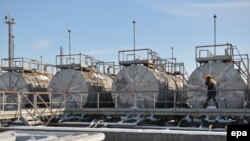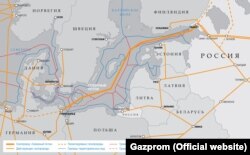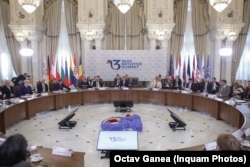Political commentator Vladimir Kornilov told Sputnik Radio on September 24:
“Poland, the Baltic States and, for some time now, Ukraine, without even realizing that they are acting to their own detriment, are trying to do everything they can to, as they see it, harm Russia. That is why they are impeding the expansion of Russian gas projects and acting solely for the sake of the United States, contrary to their own national interests.”
That statement is false.
It is true that Poland, the Baltic states and Ukraine vehemently oppose the new natural gas mega-pipelines that Russia is building under the Baltic Sea and the Black Sea. However, they do so not to please the United States or against their own national interests, but, on the contrary, to protect their own energy security in line with their national interests.
Since 2006, when the idea of building the Nord Stream 1 natural gas pipeline under the Baltic Sea was first floated, Moscow’s main goal has been to bypass the Baltic states and Poland and deliver gas directly to the Western European markets. Russia simultaneously laid the ground for rerouting the gas transit from Ukraine to the Baltic Sea and eventually suspending all gas transmission through that country and most of Central and Eastern Europe if Nord Stream 2 is completed, Western energy analysts and political leaders contend.
The project would undermine European energy security by limiting the diversity of both supply and transport options for other suppliers, in order to make the EU markets more dependent on Russian gas and allow Moscow to exert greater influence in Western Europe. Hence, all along, contrary to Moscow’s claim that Nord Stream 1 was a purely commercial project, the Kremlin has been pursuing geopolitical objectives, along with the economic and commercial benefits.
Ukraine’s Concerns
Ukraine is extremely concerned that Gazprom will divert Russian natural gas from its vast transmission system to Nord Stream 2 and TurkStream, if the two pipelines are completed. Russia currently uses the Ukrainian transit route for half of its gas exports to Europe and Turkey. Combined, the Nord Stream 2 capacity of 55 billion cubic meters a year (bcm/y) and TurkStream’s capacity of 32.5 bcm/y exactly match the volumes now transmitted to Europe via Ukraine. Ukraine’s gas network transmitted 93.5 bcm in 2017 and 86.8 bcm in 2018.
The two new Russian pipelines may cost Ukraine not only three billion euros in lost annual revenue and the corresponding impact on its GDP, but they also might leave Ukraine more vulnerable to security threats from Russia, experts and European leaders say.
Polish Prime Minister Mateusz Morawiecki warned that if Russia no longer needs the Ukrainian transit route, Moscow could launch a massive land offensive against Ukraine without fear of interrupting Gazprom’s exports to Western countries.
Poland’s Objections
The 55-billion cubic meters Nord Stream 2 natural gas pipeline, currently under construction in the Baltic Sea, will double the capacity of the existing Nord Stream 1 gas pipeline and deliver a whopping 110 billion cubic meters (bcm) of natural gas through a single route to one country, Germany. This volume represents over 70 percent of all Russian gas supplies to the European Union.
These enormous volumes of natural gas will be coming to Germany and then transmitted to Central and Eastern Europe from west to east – from Germany to the Czech Republic, Slovakia and Hungary. According to experts, these large natural gas volumes will likely overburden the transit gas networks in the region, which are designed to transmit natural gas from east to west -- from Ukraine and Belarus to Central and Western Europe. There are already choke points in the gas transmission networks of Central Europe that obstruct gas flows coming from the west.
With such huge volumes of Russian gas flowing from Germany to Central and Eastern Europe, alternative gas suppliers, such as LNG providers, will have a hard time accessing the European gas market. Thus, Nord Stream 2 will undermine the creation of regional gas markets.
Warsaw is worried that if Nord Stream 2 is built, Russia will switch the direction of natural gas supplies to Poland – from the eastern direction via YAMAL pipeline to the western direction via the OPAL pipeline. The OPAL pipeline is linked to Nord Stream 1 and connects with the YAMAL, which currently supplies Poland with natural gas from Russia
To protect their energy security and national interests, Poland, the Baltic states and Ukraine have initiated projects to diversify their gas supplies, upgrade pipelines, build LNG facilities and new gas storages, launch new regional initiatives, such as the Three Seas Initiative and the Baltic Pipeline Project. Evidently, this was done not to harm Russia or satisfy the Unites States, but to enhance their own energy security.
Crucial European Court Ruling on OPAL
The natural gas currently delivered through the offshore Nord Stream 1 is carried on-shore by the southbound OPAL and westbound NEL pipelines in Germany. For the gas coming to Germany from Nord Stream 2, Gazprom is planning to build, with its subsidiaries and related companies, EUGAL, a new pipeline from the German coast to the Czech Republic with a capacity of 55 bcm/y, exactly the same as Nord Stream 2.
But Gazprom’s ability to use the full capacity of gas transmission pipelines on European territory has changed because of opposition from Poland, which filed a legal challenge in 2016. On September 10, the European Court of Justice overturned the European Commission’s 2016 decision to allow Gazprom to use OPAL at 100 percent. Now, half of its capacity will be reserved for third party suppliers, as the EU Gas Directive mandates. Lithuania and Latvia supported Poland when it brought the case to the General Court of the European Union, a constituent part of the European Court of Justice, in 2016.
The General Court found that the 2016 decision of the European Commission was adopted in breach of the principle of energy solidarity of the European Union.
This ruling is particularly worrying for the Kremlin, because it means that Gazprom would not be able to use the entire capacity of the Nord Stream corridor: instead of 110 bcm of natural gas, it will be limited to no more than 65 bcm. This ultimately means that Gazprom will have to continue using the Ukrainian transit for some time, unless it builds three more on-shore pipelines in Germany.
The Russian energy expert, cited by Radio Sputnik, targeted Poland, the Baltic states and Ukraine shortly after the European Court of Justice announced its decision on OPAL. Poland -- supported by Lithuania and Latvia -- has won the legal case it filed challenging the 2016 European Commission decision to grant Gazprom full access to the pipeline.
The facts expose as false Kornilov’s claim that these countries are acting against their national interests by opposing Russian gas projects.









